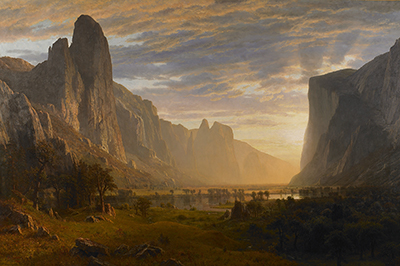Looking down Yosemite Valley is an excellent painting by Albert Bierstadt (born 1830-1902), a German American painter. He later became well known due to his extraordinary artwork on his painting.
Albert Bierstadt would conduct extensive research about his work and could even make 50 sketches of a single picture. Yosemite Valley, California by Albert Bierstadt was painted in 1865 as his first large scale picture on Yosemite. This painting is based mainly on the sketches made in 1863 during a visit to Bierstadt paints the valley from a vantage point above the Merced river looking due west. It depicts one of Americas scenic spots.
Content of the Painting
This painting is drawn on a massive canvas of about five by eight feet and offers a panoramic view down the valley of about twenty to thirty miles. It draws its audience to enjoy the beautiful spectacle by themselves. This incredible painting by Albert Bierstadt indicates how Yosemite had been isolated geographically until the midcentury when the California gold rush brought people to the valley in 1848. He exposes the valleys landmarks, which is the granite block of the el captain on the right side of the canvas, and on its opposite side is the spires of the sentinel rock and great masses of cathedral rocks.
Bierstadt has also used a golden haze to soften the edges of these extra magnificent cliffs, which may be seen as manipulating the truth. The middle of the two blocks is a space bathed in the golden light that stretches to the clouds. This painting does not include any aspect of humans or wildlife. Scholars associate this as a commentary on the civil war that had just ended, and there was post-war unrest, and Americans were searching for beauty in any form. The scholars claim this was the reason that pushed Bierstadt to paint the painting.
Where You can Find the Painting
This painting gave Bierstadt a position of honour during the 1865 annual art exhibition in New York, and it later travelled to four other destinations in 1866. Uranus H. Crosby purchased it from Chicago for $20000, which was the highest amount of money ever paid for a painting by that time. In 1991 it was given to the Birmingham museum as a gift from the Birmingham public library. The painting remains in the Birmingham museum up to date for viewing by the local people and tourists who would like to see the marvels of this fabulous painting. Those interested in this style of art should also check out the related work of Thomas Cole, with paintings such as The Oxbow, The Course of Empire: The Consummation of the Empire and The Titan's Goblet.




